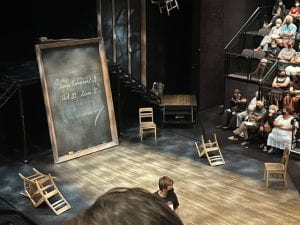Friday we had scheduled two plays, a matinee and an evening performance. Two bittersweet comedies: All’s Well that Ends Well and 1939. The first returned us to the Tom Patterson Theater, the newest venue on the banks of the Avon.
All’s Well makes you question its title, because its themes are rejected love and disloyalty to country. And the title is repeated twice in the dialogue, so you start to wonder. Helen places her heartfelt love before the audience at the beginning, but it gets rejected by the callous and superior Bertram. We see her resourcefulness and kindness by the curing of the King’s fatal illness and her plan to follow Bertram into battle and somehow win him back. Although she succeeds with the help of sympathetic allies, I feel a strangled joy at the extreme measures she needed to woo Bertram back.
Likewise the comic character Parolles, a companion to Bertram, who, despite his bravado, betrays his friend and his army, once he is captured by his fellow soldiers, blindfolded and probed for the secrets and vulnerabilities of Bertram’s and their cause. Parolles is stripped of his uniform, his wig and his mustache, but somehow returns home rehabilitated, a repentant figure.
Does all end well under the circumstances of betrayal and rejection? That is the question that lingers into the companion production of 1939.
A performance by indigenous adolescents of the play All’s Well that End’s Well for the King and Queen of England is the premise of 1939. I never did learn the significance of the title.
The play moves briskly through the rehearsals and trauma of the students at a Residential School for indigenous children. You see the official board announcing the rehearsals below. Behind this board are smaller slanted boards that reveal messages from the students that are erased between each scene by the older white leaders of the school, the teacher/ director and the Episcopal priest. The symbolism is clear: the identities of the indigenous students are erased by the curriculum of the school.
What surprised me was the humor injected by the students, who, through their pain of lost tribal identity, still labor over this performance and begin to inject their own culture into the script. The local news reporter sees the struggle to marry Shakespeare and indigenous life, and applauds their effort, calling their emerging production an “Indian Shakespeare.” The overturning of the adults’ plans to produce authentic Elizabethan drama becomes hilarious, along with the priest’s tendency to fart nosily and foully when he is nervous.
After a chaotic presentation, the young people feel validated, but their future remains clouded with limited opportunities. They separate to go to different roles in pedagogical study, the army, the theater and returning to home to farm.
At the close of the play we were invited to view an installation about the Action of the Truth and Reconciliation Commission, and to spend time reflecting on the performance with an indigenous instructor, a woman who teaches secondary teachers about indigenous culture and methods of learning. We sat in a circle, a format that equalizes all members of the tribe. We all had questions about the survival of culture and work of the Truth and Reconciliation Commission, and the instructor was forthcoming and conciliatory about the resistance to colonialism in Canada. Her conclusion: “colonialism sucks.”
We spent the day walking between these companion performances from the modernistic Patterson Theater to the intimate Studio Theater, indulging in more buying, eating and drinking at the Heritage Brewery, and bumping into Marty and Hope twice before encountering them at 1939. Stratford is a small town, and we tourists are a small community. We even bumped into two University of Detroit professors at the end of 1939. One was a teaching methods instructor, who told about the elimination of his program at U of D.
We will round out this visit with brunch with Hope and Marty and a matinee performance of Little Women. The reviews from our friends and the U of D professors have contradicted each other. We’ve already been warned it is very unconventional, but that’s Stratford.


